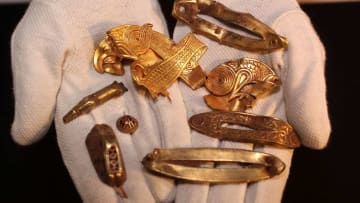
20 Amazing Historical Discoveries in the Last 20 Years
Scientists and historians have made incredible finds—from the oldest human-made art to long-lost shipwrecks—in the 20 years since Mental Floss began.


Scientists and historians have made incredible finds—from the oldest human-made art to long-lost shipwrecks—in the 20 years since Mental Floss began.

The Great Pyramid, the Great Sphinx, and the rest of the Giza Plateau’s many wonders are a few clicks away.

London's mudlarks hunt for treasures in the River Thames's tidal sands, finding everything from Roman pottery to human bones.
Sometimes deliberately, often unintentionally, countless artifacts have been buried—and then rediscovered—under parking lots.
People have long believed that a 1954 cemetery relocation process in Clearwater, Florida, was incomplete. They were right.
The massive brewery uncovered in the ancient Egyptian city of Abydos was capable of producing 5900 gallons of beer at a time.
Bogs have an almost magical power to preserve organic material. From butter to bodies, here are 11 of the most amazing things archaeologists have recovered from bogs.
A gold figurine unearthed by a metal detectorist in England turned out to be the centerpiece of King Henry VIII's long-lost crown.
New research suggests that the real-life inspiration for Ghost from 'Game of Thrones' wasn’t a wolf species.
Construction of a new park in Mayfield, Manchester, uncovered a bathhouse used by factory workers 150 years ago.
Last September, an unnamed bird-watcher found a trove of 1300 Celtic gold coins dating back to the 1st century CE.
Aztec peoples considered human sacrifice an integral, life-sustaining ritual, and the sacrificial skulls were prominently displayed.
It’s far from the first time an ancient mummy has been scanned, but this technology isn’t any old X-ray.
Henry VIII nearly lost his life while jousting in 1536. Now, archaeologists have located the site of the history-making accident.
Archaeolgists in Norway recently uncovered a sword buried on a Viking’s left side, indicating that the Viking likely wielded it with his left hand.
“I see it, I like it, I want it, I got it.” —Ariana Grande and also the avaricious rats of Oxburgh Hall.
New archeological evidence pushes back the arrival of the first North Americans 15,000 years and suggests they occupied the Americas during the Last Glacial Maximum, 26,000 to 19,000 years ago.
During in excavation in Buckinghamshire, England, a skeleton was found lying face-down with its hands tied behind its back, indicating that it belonged to a possible murder victim.
After telling tourists to stay away from Stonehenge on the summer solstice, English Heritage has announced it will be livestreaming the event for the first time in the landmark's history.
Before the Mount Vesuvius eruption of 79 C.E., these homes in Pompeii featured gardens and impressive art collections.
From fossilized feces to antediluvian rodent nests, ancient objects are getting their DNA analyzed for clues about the past.
Florida's Treasure Coast is filled with artifacts from an 18th-century shipwreck, as a group of friends demonstrated recently when they found 22 silver coins there.
Earlier this week, England’s Parliament announced that a secret door had been discovered in the walls of Westminster Hall. Inside, historians found “graffiti” left in 1851 by a bricklayer who was “fond of Ould Ale.”
A pair of epaulets, a pencil case, and a glass decanter were found at the Arctic shipwreck, which continues to reveal clues to the fate of the doomed 19th century expedition.